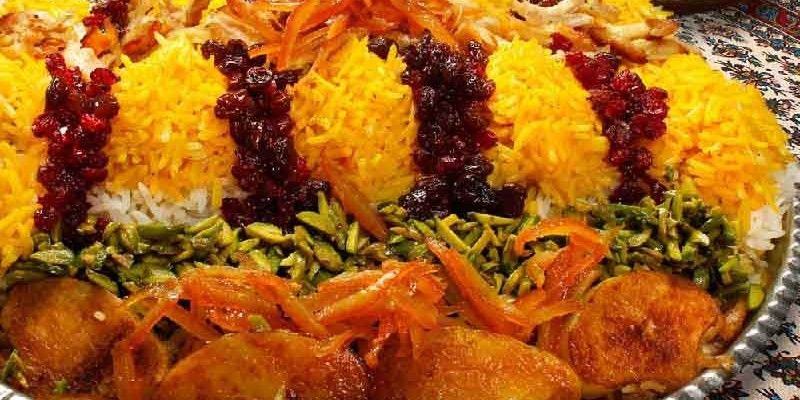Morasa Polo, also known as Inlaid Rice, is a traditional Iranian dish that is not only delicious but also packed with nutritional benefits. This dish is made by layering rice with a variety of ingredients such as saffron, barberries, pistachios, almonds, and raisins. Here you can read everything about Morasa Polo, the fancy and rich Iranian food.

The Colorful Morasa Polo - Iran
History of Morasa Polo
Morasa Polo, Javaher Polo, Inlaid Rice or the Jeweled Rice, has been cooked in Iran since Safavid Dynasty (16th to 17th Century) when Iranian culinary had a big development and many royal Iranian cuisines were invented at this time. Since garnishing this Iranian food is as important as its taste, and it is covered with different types of pricy nuts and colorful fruits, this food is among the fancy and luxurious Iranian cuisines.
Morasa Polo is a rice dish mixed with chopped chicken or minced lamb meat or meatballs, and lots of brewed saffron, and it is topped with different nuts and fruits some of which are the symbol of a desired gemstone; barberries come as rubies, pistachio pieces represent emeralds, and carrot or candied orange peels are the symbol of gold. Other elements added to this delicious food include almonds, sour cherry, plums, and some sugar and raisins to balance the sourness of other ingredients. On the other hand, the word “Morasa” in Persian means a surface which is designed with pieces of jewels. So now you know why this food is called the Jeweled Rice!

Morasa Polo the Fancy Iranian Food
Morasa Polo Recipe
Here you can read the recipe of Morasa Polo, the rich, nutritious Persian food:
Soak rice in warm water for an hour. Fry the little chicken pieces in onion and spices until color changes. You can also cook Morasa Polo, with minced lamb meat or meatballs.
Fry the washed barberries and raisins over medium heat for a few minutes to soften it a little, and add a teaspoon of sugar to the barberries while frying. Then cut the orange peels in very thin slices and boil them for a few minutes and drain and repeat this process 3-4 times and then boil them with a few spoons of sugar for a few minutes to sweeten the orange peel and drain for the last time.
Meanwhile, cook the rice in the boiling water and add some oil and salt and drain the rice after 15 minutes. The rice should not be too raw, and not too much cooked or mashed.
Add half of the cooked rice to the pot and cover it with the fried chicken pieces, or minced lamb meat or meatballs. Then add the rest of the rice and then pour a cup of brewed saffron on the rice.
Let it cook for one hour. Then put the cooked rice and chicken in a serving tray and design it with orange peel, almond and pistachio pieces wich are fried with onion slices, barberries, cooked sour cherries, and grated, fried carrots and then serve your tasty, nutritious and aromatic Morasa Polo.
 |
| Morasa Polo (Jeweld Rice) - Iranian cuisine |
Nutritional Values of Morasa Polo
One of the main nutritional benefits of Morasa Polo is its high fiber content. The rice used in this dish is typically brown rice, which is a great source of fiber. Fiber helps to regulate digestion, prevent constipation, and lower cholesterol levels.
Another benefit of Morasa Polo is its high protein content. The nuts, the meats and dried fruits used in this dish are all excellent sources of protein, which is essential for building and repairing tissues in the body.
Additionally, Morasa Polo is rich in vitamins and minerals. Saffron, which is often used to flavor the rice, is a great source of antioxidants and has been shown to have anti-inflammatory properties. Barberries are also high in vitamin C, which helps to boost the immune system and protect against infections.
Book a Tour with PackToIran team and enjoy the Taste of Mosara Polo and Other Iranian Couisines:


